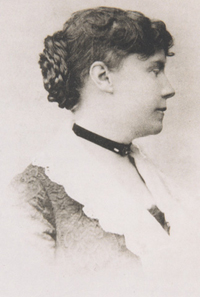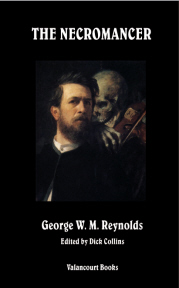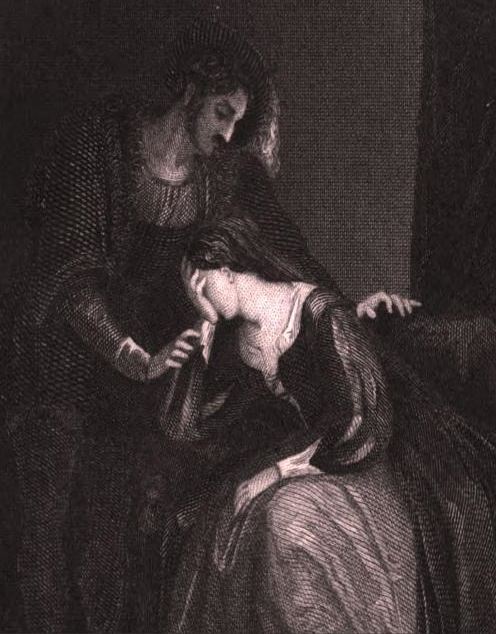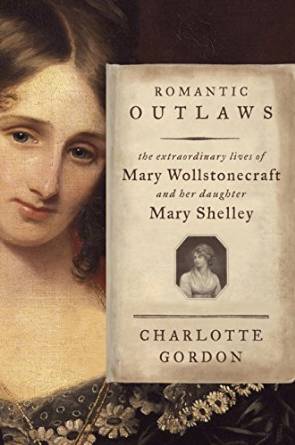Constance Fenimore Woolson (1840-1894) is generally regarded as an author of realism, but she was influenced by her famous great-uncle, James Fenimore Cooper, to create Gothic forest and island scenes in her early novella Castle Nowhere (1875) set near the Mackinac Straits, and while her later works are always set within the real world without any traces of the supernatural, she still used many Gothic elements to enhance her themes.

Constance Fenimore Woolson – the author of Jupiter Lights, whose title refers to lighthouses in Florida and on Lake Superior, both places Woolson visited and wrote about extensively.
Woolson’s third novel, Jupiter Lights (1889), was regarded by many at the time of its publication as Woolson’s best work. After her death, however, Woolson—despite her first novel Anne (1882) being a bestseller in its day—was largely forgotten, and even when women’s texts were revived in the later twentieth century as a result of the women’s movement, Woolson remained in the shadows. I find this surprising because the heroine of Jupiter Lights, Eve Bruce, is one of the most surprising and even desperate heroines in literature, a woman not afraid to act as needed in a moment of crisis, and a character whom I believe Woolson was using to comment on and reverse old Gothic and biblical stereotypes about women. However, her rebellion against a patriarchal establishment through the pseudo-transgression she commits may have resulted in the men who determined the literary canon and even women who thought the novel went too far from celebrating this novel’s extraordinary achievement.
Gothic novels are frequently about a transgression that the main character commits and then feels deep regret over. As I’ve explored in detail in my book The Gothic Wanderer, the Gothic novels of the 1790s and beyond were highly influenced by Milton’s Paradise Lost (1667), a retelling of the Garden of Eden story. In both the Bible and Paradise Lost, Eve transgresses by eating the forbidden fruit of the tree of knowledge, and that story has been used for centuries to justify making women second class citizens to men. Can it be any accident then that Woolson names her heroine Eve? It is a heavy name to bear, so I believe Woolson knew fully her intentions in using it for her main character.
The novel begins in the years following the Civil War. Eve has been living in England but now returns to the United States. Her brother Jack had married a Southern belle, Cicely, and then died during the Civil War, but not before leaving a son, also named Jack. When Eve arrives in the South to visit Cicely and her nephew, she quickly learns that Cicely has remarried to a man named Ferdie. Eve is shocked by this second marriage when she is herself still grieving her brother. Soon after, she decides Cicely is not a fit mother for Jack and she begins to plot how she can take away Jack and raise him herself. To some degree, Eve seems overly emotional in her grief, and while she does not consider kidnapping Jack, she does continually try to convince Cicely to give him to her, thinking Cicely neglects him.
During this time, Ferdie is in South America on business, but when he returns, Eve soon learns the truth about Ferdie and Cicely’s marriage. Ferdie is an alcoholic, and when he is in his drunken stupor, he can explode into a rage; he is not above beating Cicely, and even worse, he once broke little Jack’s arm. Ferdie also suffers from more than drunkenness; he has a hereditary type of madness that at times consumes him. Woolson’s biographer, Anne Boyd Rioux, notes that Henry James was friends with Robert Louis Stevenson, whose The Strange Case of Dr. Jekyll and Mr. Hyde appeared in 1886. We don’t know whether Woolson, who was close friends with James, read Stevenson’s book, but Mr. Hyde is not such a far cry from the same kind of tormented man who can turn into a monster that she depicts in Ferdie, and not unlike Milton’s Satan, who changes from an angel into a demon, Ferdie has “hell within him” and is largely helpless to dispel it.
Eve is horrified at the danger to her nephew that Ferdie represents, so she plots even more to get Jack away, but before she can accomplish it, the family goes to Singleton Island to visit relatives. While there, Ferdie flies into one of his drunken rages and it is clear he intends to murder Cicely. In the night, Eve flees from the house with Jack and Cicely. They journey through the swamps to reach a boat to escape in during the most Gothic scene in the novel. With Ferdie pursuing them, the women climb into the boat, but Eve, realizing Ferdie will be upon them before they can push off, in desperation, shoots Ferdie. Then leaving his fallen body behind, the women make their escape.
Cicely feels that the only safe place for them to go is to Ferdie’s brother, Paul, who lives far away in a mining town called Port aux Pins, on Lake Superior, in Upper Michigan. The women journey there, all the while dreading both that Ferdie will pursue them and also that Ferdie has been killed. The words Woolson uses here to describe Eve’s agony are significant:
“But, once away, the horror had come, as it always does and must, when by violence a human life has been taken. She had dropped the pistol into the Sound, but she could not drop the ghastly picture of the dark figure on the sand, with its arms making two or three spasmodic motions, then becoming suddenly still. Was he dead? If he was, she, Eve Bruce, was a murderer, a creature to be imprisoned for life,—hanged. How people would shrink from her if they knew! And how monstrous it was that she should touch Cicely! Yet she must. Cain, where is thy brother? And the Lord set a mark upon Cain, lest any finding him should kill him. Would it come to this, that she should be forced at last to take her own life, in order to be free from the horror of murder? These were the constant thoughts of that journey northward, without one moment’s respite day or night.”
The mark of Cain is a frequent Gothic theme. The Wandering Jew and other Gothic Wanderer characters carry the mark of Cain on their brow, a sign that they are murderers or transgressors, and, therefore, cursed by God. Eve believes the only way to free herself from her guilt is to commit suicide, which is also a common Gothic theme. Many Gothic wanderer figures, including the Wandering Jew and the title character of James Malcolm Rymer’s Varney the Vampyre (1846) seek to destroy themselves. These two characters, in particular, often try to drown themselves or jump into volcanoes, but the sea and the volcanoes spit them up, refusing to let them die. Eve does not go so far as to attempt suicide, but later in the novel, she will try to lock herself away to prevent her murderous act from continuing to hurt those she loves, especially Paul.
While in Port aux Pins, the women remain silent about what happened to Ferdie. In time, Paul receives news that Ferdie was shot, and two negroes are suspected of having shot him. Eve then believes she is cleared from suspicion, but she holds guilt within her heart, even though she felt obligated to shoot Ferdie to save Cicely and Jack’s lives that night.
Cicely has fallen into a sort of mental illness by the time they reach Port aux Pins, so she is unable to provide any clarity about what happened to Ferdie. She only knows that she loves him and she wants to return to him when she learns of his gunshot wound, although Paul and Eve persuade her otherwise. She falls into great despair when she then hears that Ferdie has died.
Ferdie’s death leaves Eve in anguish over the belief that she is a murderer. Her anguish is all the greater because now she is falling in love with Paul. Added to that, Paul declares that if he ever finds out who killed Ferdie, he will shoot that man. He says he could never forgive his brother’s murderer—it must be blood for blood. Matters become more complicated when soon after, Paul and Eve confess that they love each other. However, Eve says she cannot marry him because a barrier lies between them. Paul thinks she means that she loves another man, and Eve lies when she confirms that she does because she feels she could not bear his anger and hatred if she confesses that she killed his brother.
Meanwhile, Cicely is consumed with grief over Ferdie’s death. She now curses Paul for not letting her go to him before he died, saying, “If you trust anyone, I hope that person will betray you,” an eerie foreshadowing for the day when Paul will likely learn the truth about Eve and the murderous act she committed.
Finally, consumed with guilt, Eve confesses to Cicely that she shot Ferdie. At this knowledge, Cicely goes mad. She begins reliving the events of that night and thinks they are on Singleton Island again where they were the night they escaped from Ferdie. Madness is also a common theme in the Gothic, although typically only the women go mad, such as Bertha Rochester in Jane Eyre, or they are accused of madness and locked up, as in Wilkie Collins’ The Woman in White.
When Cicely eventually regains her senses, she sees Paul and Eve together and realizes they are in love. She then threatens Eve with telling Paul the truth, but before she can, the novel’s most dramatic and, for this reader, terrifying event occurs.
Jack is placed in a boat on the beach and inadvertently the boat gets washed out into the lake before anyone can stop it. Eve quickly gets into another boat and begins paddling out onto Lake Superior in pursuit, while Cicely finds a man to get another boat and follow her. The scene is terrifying because Lake Superior is enormous, and several times, the women lose sight of Jack’s boat. Many times they must call to Jack on the lake and listen for his cries and then try to follow in that direction, sometimes seeing the boat, sometimes losing sight of it. Woolson refers to the women here as “wanderers” as they cross the lake on their desperate quest. Living as I do on the shore of Lake Superior, I can well-imagine how terrifying as well as realistic this scene is and how nearly impossible it would be to catch Jack’s boat.
Eventually, the women are able, despite the wind and waves, to find Jack, aided somewhat in the night by the lightning flashing in the sky. They get close enough to Jack’s boat to pull it behind theirs, but then it becomes filled with water and Eve has to jump into it to grab the sleeping Jack as it capsizes. For a moment, Eve and Jack are underwater, and then they come back to the surface. Eve hands the boy to Cicely and somehow they make it to shore.
Cicely is now so grateful to Eve for saving Jack that she promises not to tell Paul the truth about Ferdie’s death. The near drowning is almost like a baptism for Eve, as if to redeem her sins, since she gains Cicely’s forgiveness. She has also had to sacrifice her life for another’s here, just as Christ did.
But despite Cicely’s promise, Eve is consumed with guilt, so she finally tells Paul the truth, including all the details of how Ferdie threatened their lives.
The women now return South with Jack, but Cicely remains mentally unstable. She wants to return to Singleton Island and the place where the murder happened. When she and Eve go there, she loses control of her emotions and tries to choke Eve, declaring, “How do you like being dead?” Fortunately, she then faints and Eve carries her “sister” home. This scene is significant with the wording “sister” because in the Bible, Cain tells God that he is not his “brother’s keeper” and yet Eve, who equates herself with Cain, is now caring for her “sister.” She acts more like a Christian than a murderer here, and in doing so, she is replacing the Old Testament law of vengeance with the New Testament gospel of turning the other cheek and loving your enemy.
Paul now follows the women South. He finds Eve and proposes to her, telling her he understands why she shot Ferdie and that she was brave to do it, but she refuses his proposal, saying he will hate her later. She then flees to Europe without Paul knowing, and Paul is angry when he learns that Cicely did not try to stop her. Cicely only replies that she wants to make Eve suffer.
At this point, Dr. Knox, who had attended Ferdie when he was dying, returns from a trip abroad. He had gone just after Ferdie had died so he had never been able to communicate the details of Ferdie’s death to Paul. He now tells Paul that he had cured Ferdie of the bullet wound, but Ferdie died soon after from a series of drinking sprees.
Relieved by this news, Paul goes to Italy to find Eve. She is in a “retreat center,” but Paul fears it is really a convent and that she is planning to take vows. Gothic novels are full of convents in which women are often forced into vows. The women at the retreat center tell Paul no one is being forced, but Paul is desperate and even violent as he pushes people aside and tears through the building until he finds Eve and takes her in his arms, and so the novel ends, with the assumption that Paul tells Eve she is not guilty of murder.
I find this novel fascinating because Woolson is clearly rejecting and reversing the role of transgressor in her character Eve. While Eve is ultimately relieved from the guilt of being a murderer, she is also not afraid to stand up to the patriarchal system that enslaved women—in this case represented by Ferdie, who is the true Gothic monster of the novel. In other words, Eve’s attempted murder of Ferdie, which can be seen as a rebellion against the patriarchal system, is not the transgression society would have us believe. The final scene where Paul tries to free her from the convent suggests that the old secrets often contained in monasteries and castles in Gothic fiction are now free to see the light of day. In fact, that no one is forced to take vows in the convent suggests that women no longer need be imprisoned in their lives by men or religion or social pressures.
Paul’s violent entry into the convent is also an act of defeating the past, like a storming of the Bastille, and pushing away the old to make way for the new. Would it be too far to equate Paul with St. Paul, preacher of the New Testament? After all, his last name, Tennant, might be translated as “tenet,” which isn’t a far cry from “testament.” Just as Christ redeemed mankind and replaced the Old Testament with the New, so Paul can love a transgressive woman and in a sense redeem her, though in truth, she needs no redemption for she is not a transgressor since she is not guilty of murder.
In the Bible, Eve says that the serpent made her eat the fruit. Modern language has turned this concept into the phrase, “The devil made me do it.” The same may be said in this novel, if Ferdie is seen as the devil. Eve did what she had to do to protect herself and Cicely and Jack, and in that sense, shooting Ferdie was self-defense. It was not a true transgression. Even so, when Eve learns that she is not a murderer, she also need no longer feel like she is cursed and bearing the mark of Cain. Instead, she is free to marry Paul—in a sense, she is redeemed by the “good news”—the gospel—that he preaches to her of her innocence, which frees her from what may later have been the confinement of a convent.
Eve Bruce is a true Gothic wanderer both justified in her transgression and redeemed even though it turns out she never needed redemption.
Even the most ardent feminists would not publicly advocate murdering an abusive husband, even in self-defense, and so I suspect that is why this novel and Woolson have not yet been embraced by feminist scholars. Even so, Eve Bruce is a true champion for women’s rights and one of the most powerful female characters in literature, a woman with a guilty conscience who nevertheless acts when necessary to protect those she loves. She is a female Gothic wanderer and one of the most extraordinary ever created.
________________________________________________
Tyler Tichelaar, Ph.D. is the author of King Arthur’s Children: A Study in Fiction and Tradition, The Gothic Wanderer: From Transgression to Redemption, and the Children of Arthur series. You can visit Tyler at www.ChildrenofArthur.com and www.GothicWanderer.com
















